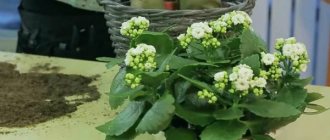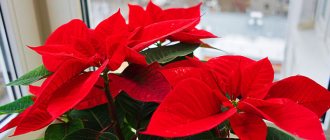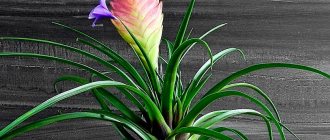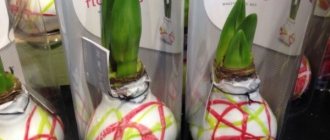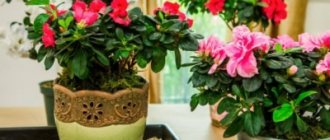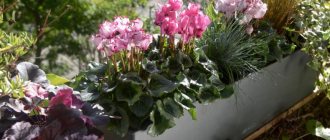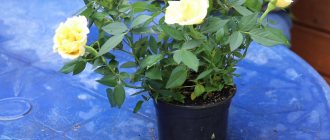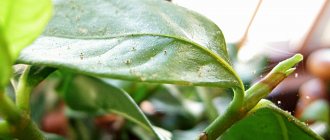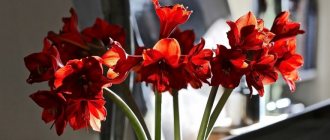Begonia Elatior at home
Among the representatives of indoor flora, begonias are especially beautiful. Inhabitants of the tropical forests of South America, Asia, Africa, and India are so popular that every experienced gardener has at least one copy. If you decide to have a plant that will delight you with bright flowers, pay attention to the Elatior begonia hybrid at home; it will give you stunningly beautiful flowering twice a year. Growing, caring for and propagating a flower is not an easy task. The material in the article will help you choose a good variety and create optimal conditions for the development of the crop, and the advice of experienced gardeners will teach you the intricacies of caring for a tropical guest.
Peculiarities
In botany, begonias are commonly called perennial ornamental plants that inhabit the highlands of hot tropical forests. A characteristic feature of this species is the pronounced asymmetry of the foliage. The flowers are quite lush; you can grow the crop both at home and outdoors. The specific name is given by the name of the discoverer (Begon). The species has been confirmed to grow in India, South America and African countries.
Begonia was first discovered and described in the Antilles. Based on the initially discovered 6 species, breeders have managed to develop more than 1000 varieties. The height of the plant is relatively small. For decorative purposes it is used mainly for interior decoration. The use of begonias as climbing crops is also common.
Begonia elatior is distinguished by its lushness. It is readily bought in flower shops because it can be used to make beautiful bouquets.
A number of studies have convincingly proven that this plant effectively suppresses the development of microbes. Basically, the phytoncides secreted by the flower fight staphylococcus. Therefore, begonias have become frequent guests in medical institutions and kindergartens.
Plants reaching 0.25-0.37 m are considered tall. The average growth group includes varieties whose height ranges from 0.15 to 0.18 m. The shortest begonias grow to only 0.08-0.15 m . released today:
- varieties with straight stems;
- begonias with a shrubby structure;
- creeping flowers.
There is a variety that can bloom all year round. However, it is impossible to grow it outside in the Russian climate. This plant requires continuous heat. Traditionally, begonias are divided into 3 main categories:
- deciduous-decorative (with large or medium-sized leaves covered with wide stripes);
- bush (without pronounced specificity);
- tuberous (representatives of the group differ from each other only in stems and flowers).
Important: begonias can form different root systems, depending on the conditions of detention.
The roots of street specimens are tubers. Indoors, rhizomatous or fibrous roots are formed. The tuberous type produces the tallest and strongest stems. But the other two types of root systems are more suitable for planting in decorative baskets.
Begonia Elatior – description, photo
Elatior is a herbaceous perennial with the habit of a lush bush up to 40 cm high. The stems are erect, fleshy, gnarled. Leaves with a serrated edge reach a length of 8 cm. They are arranged on the stem in a regular order and are attached with a long petiole.
The surface of the plate is dense, bright green, glossy. The reverse side is light green, matte, covered with a network of pronounced veins. The interesting heart-shaped leaf shape is complemented by slight asymmetry.
This is interesting! Succulent flowers can be double or simple in shape. Terry buds look especially impressive, looking like miniature roses, camellias, and peonies.
The beauty of the hybrid lies in its very long flowering period. Appearing at the end of summer, the buds will bloom for six months. Indoor flowers that can present bright blooms in winter are invariably popular. And lush bushes with bright greenery and luxurious double flowers with a diameter of 4-5 cm are attractive as a gift.
Loose inflorescences appear from axillary leaves and are located on a long peduncle. The flower stalks rise above the dense greenery, the corollas gradually bloom. The color of the petals varies - from white and cream to rich wine. The tone of the petal and the shape of the corolla depend on the variety.
Origin and varieties of hybrid
As mentioned at the beginning of the article, Elatior is of hybrid origin. From the numerous genus Begonia, numbering 1,600 wild species, the tuberous and Socotrans varieties were isolated to create a hybrid. From its “parents”, the luxurious exotic has inherited the best decorative qualities - a combination of compact dimensions, long-lasting abundant flowering and rich colors of the corolla. Crossbreeding work was carried out by breeder Rieger in 1903. The botanist gave his brainchild the beautiful name Elatior.
The further process of hybridization led to the emergence of a mass of new cultivars, differing in growth, color and corolla shape. In addition, Rieger endowed the hybrids with high resistance to fungal diseases. Other scientists began to call the resulting variety group the Rieger race. Belgium, Denmark and Holland made a major contribution to modern selection.
Interesting fact! The second name of the described plant is winter begonia. John Veitch (Veitch) identified representatives of the genus with a winter flowering period as a separate class.
Wild relatives of the flower were discovered in 1687 by botanist Charles Plumier. The scientist named the genus in honor of Michel Begon, who sponsored a scientific expedition along the coast of the Caribbean and Bahamas. In Russia, exotics have been known for a long time, as evidenced by the popular nickname “Napoleon’s ear.” The name was given after the end of the Patriotic War of 1812, noting the similarity of the shape and color of the leaf plates with the frostbitten ear.
Elatinor began to be used as a pet from the end of the 19th century. In just over a hundred years, new varieties have appeared, which are classified by flower shape into double and non-double, and by growth into short, medium and tall. Tall ones reach 60 cm, medium-sized ones reach 30-40, and the low-growing group includes miniature bushes up to 25 cm tall.
Let's take a closer look at the characteristics of individual varieties that have won the love of flower growers:
- Anabel. The cultivar belongs to the group of medium-sized varieties, reaches a height of 30–35 cm. Decoration of a bright green bush - bright semi-double yellow buds of Anabel are often used as a decorative seasonal annual to decorate the garden. The crop is grown from late autumn to mid-summer.
- Azothus. The height of this potted plant reaches 30 cm. Large rose-like flowers with double petals bloom on dense bushes.
- Barkos. The hybrid reaches 40 cm and grows on the windowsill all year round. In summer, planting in the garden is acceptable. The corollas of Barkos are very large and fluffy, the color of the petals is bright scarlet.
- Borias. Cultivar of English selection for indoor growing. The compact bush bears both double and single flowers, sitting on a long multi-tiered peduncle. During the flowering period, a lush cap of a soft pink hue rises above the shock of shiny foliage. A white edging runs along the edge of the petals. Unpretentious Borias is suitable for growing in office premises.
- Bellona. This medium-sized plant has very large buds with double corollas. It feels best indoors; it is not suitable for creating summer garden compositions.
- Berlin. A seasonal potted hybrid, grown from early winter to mid-summer, has medium dimensions. The top of the crown is decorated with a light pink cap of double flowers.
- Cleo. The cultivar forms bushes about 40 cm high, suitable for decorating a garden, and grows from the beginning of the year to mid-summer. Cleo has gorgeous semi-double salmon-colored buds. The flowers are not large, but there are a lot of them.
- Goldfinger. Roses of a delicate yellowish-cream shade open on a dense glossy crown. Goldfinger is not suitable for open ground, but indoors it can be grown all year round.
- Baladin. Quite a popular variety, characterized by powerful multi-tiered peduncles. Balandin is called a potted bouquet due to the abundance of flowers with different colors of petals. On one specimen 30 cm tall, up to 70 corollas can bloom.
- Kyoto. A bush of medium height from the beginning of winter to mid-summer is covered with large fluffy pom-poms of snow-white color.
- Louis. The cultivar belongs to the tall group. Can grow both at home and in the garden. Blooms from November to mid-summer. It has semi-double cream petals with a pink tint.
- Piccora. On the low-growing hybrid, from the beginning of winter to July, rather large fluffy corollas of a bright pink hue bloom.
- Renaissance. This tall variety is interesting for its crinkled petals, which make up lush scarlet pompoms. It grows on the windowsill all year round, but does not feel comfortable in the garden.
- Swabia. A representative of the tall group with a simple corolla structure. The petals are deep red in color and bloom very profusely. In the garden, Swabia is often confused with the tuberous variety.
Know! The cultivar Baladin received the nickname “touchy-pants”. If you touch the petals with your hands, characteristic rusty-brown spots will remain on the skin.
You may also be interested in other varieties of Elatior - Balamon with orange roses; Batik with simple orange petals; Peggy with a white core of bright pink corolla; profusely flowering variety Veronica with large double corollas of scarlet color.
The variety series look good: Binos with dense peduncles, compact low (up to 25 cm) Charisma with very large salmon buds, the hanging Cottage Collection series with hanging peduncles, large-sized plants of the Pickles series reminiscent of the tuberous variety.
Varieties
"Borias"
Growing and caring for soleirolia at home
When talking about begonia species, it is impossible to ignore the Borias variety. It is distinguished not only by its external attractiveness, but also by its minimal whimsicality. The plant blooms once every 6 months, which is quite unusual for the species as a whole. The second flowering occurs in the autumn and winter months, while other indoor crops are resting. But such a pleasant result can only be achieved with careful care.
The maximum height of the Borias bush can reach 0.4 m. The thick stem bears leaves that look like asymmetrical hearts. The top of the leaf is colored rich green. The underside is lighter and the veins are very visible on it.
"Charisma"
“Charisma” also deserves attention. Strictly speaking, this is not a variety in the usual sense of the word, but a whole varietal group. This includes only low-growing plants with green foliage that has a glossy sheen. Terry type inflorescences are formed. Flowers may have:
- dark pink;
- dark salmon;
- orange-reddish;
- salmon-pinkish color.
"Baladin"
"Baladin" bushes grow up to 0.3 m. An attractive feature of this variety is the large number of flowers (sometimes over 70). Moreover, the tonality of the colors can vary greatly. There are also carmine-red, and simply red, and pinkish ovaries. Hence the common name – “bouquet in a pot”.
"Annabelle"
The medium-sized begonia “Annabelle” also deserves attention. This culture forms double yellow inflorescences. The plant can be grown on window sills and in open ground. Flowers last from November to July.
"Azotus"
Azotus also gives good results. True, such flowers can only be grown in a room. Pink terry buds of considerable size look attractive. Begonia growth is small.
Bellona
But in Bellona the height of the bushes is up to 0.4 m. Bright red flowers form on the bushes. The plant is only suitable for growing indoors.
"Kyoto"
The Kyoto variety produces large white buds. Again, it is worth saying that the crop is only suitable for indoor cultivation.
"Renaissance" reaches a very high height - up to 0.6 m. Its bushes bear red, double-type flowers.
"Berseba"
The unusual name “Berseba” has a very beautiful culture with abundant flowering. The plant grows calmly at moderate temperatures. It definitely needs good lighting. Begonia "Mix" is more widespread than other varieties of this plant. But the crop still deserves close attention, and the slightest mistakes when growing it can lead to unpleasant consequences.
Begonia Elatior home care
The tropical guest requires special attention from the gardener. Before purchasing a potted crop, you should know that it is very susceptible to stress and changes in environmental conditions. Only if you follow certain rules can you achieve luxurious flowering, and violation of agricultural practices can destroy a luxurious flower.
Location, lighting
The spectacular Elatior is quite light-loving. In the shade, its shiny crown will turn pale and stretch out, and the buds will begin to crumble. For a hybrid, it is important to maintain a balance between good lighting and shading, since too intense lighting will also not be beneficial. Excess light in terry cultivars will significantly reduce the fluffiness and the petals will become pale. This is due to the fact that the perennial belongs to plants of short daylight hours. Even in winter, the exotic will do without additional lighting. It is enough to cover the delicate leaves from the scorching rays of the sun with tulle, because at midday the hot rays provoke burns of the foliage.
Important! Bright diffused light is optimal for the normal development of the tropical guest.
Based on the preferences of the flower, it is better to place the flower pot on the western or eastern windowsill. If this is not possible and the windows face south, move the container with the flower away from the window or shade it with a curtain. North-facing windows will require an additional light source in winter. Experienced gardeners install a phytolamp and increase the daylight hours of the exotic plant to 9 hours. Remember that the place for the tropical guest must be permanent, because the flower will shed its buds due to changes in the environment.
Temperature
The African guest does not like even the slightest deviation from the temperature regime. When the temperature drops to 18⁰C, the sissy will lose some of its foliage and buds, and growth will slow down. Such conditions contribute to the activation of spores of pathogenic fungi, which leads to various diseases.
The lower background limit is 8-10⁰C. This is worth remembering when growing some varieties in open ground. As soon as night temperatures exceed the temperature minimum, the plant will die. You need to dig up the bush before the cool nights set in and bring it into the house, otherwise you will have to say goodbye to your green darling. It is optimal to maintain 22-26⁰C in the room.
Remember that drafts cause irreparable harm to the health of the hybrid. The delicate root system dies from hypothermia. To avoid such phenomena, first check the window sill and frame for leaks.
Advice! It is better to seal all the cracks with sealant, and place the pot on a high circle of foam plastic.
Air humidity
Since exotic plants naturally grow in tropical forests, it is important to provide them with high humidity. It is better not to resort to spraying, because droplets of water spoil the decorative effect of the flowers. If drops of water remain on the surface of the plates, under the influence of the sun they will turn into miniature magnifying glasses. Evaporation of the liquid will cause burns to the foliage. You can create optimal humidity by placing a container with a flower on a high tray filled with a damp absorbent. Expanded clay, peat or sphagnum are suitable.
Choosing a pot
The root system of the exotic plant is rather poorly developed. When choosing a container for planting, rely on the following rule - the height and diameter of the pot should be the same. That is, for planting they use wide and shallow containers. A container that is too small prevents the normal development of the root system, and in a pot that is too large, the soil takes a long time to dry out after watering.
Another important rule is the presence of wide drainage holes. Small holes can become clogged with clumps of soil and lead to the development of root rot.
Substrate
A wide selection of ready-made soil mixtures has a line designed specifically for begonias. The same soil is suitable for growing Saintpaulias, so they are considered interchangeable. The basic requirements for soil are looseness, fertility, lightness, and breathability.
On a note! To prepare your own soil mixture, mix humus, peat and leaf soil in equal proportions, add half a portion of sand.
Experienced gardeners recommend adding a little perlite or vermiculite to the finished soil. These materials are chemically neutral and do not affect soil acidity. Minerals absorb moisture, gradually releasing it to the plant. Thanks to the porous structure, they increase air exchange, the substances serve as leavening agents and help retain heat, which is very important for exotics.
Transfer
Usually the hybrid is not replanted, because the root system is very sensitive and can die from even minor damage. The purchased plant is left in the transport pot until flowering ends. If the indoor flora requires replanting, it is done very carefully, using the transshipment method. To replant a bush, use the following instructions:
- water the soil 3-6 hours before transplanting;
- Place a layer of drainage on the bottom of the selected container. Use expanded clay or sphagnum moss;
- cover part of the earth with a layer of such size that the bush is at the same level;
- carefully remove the bush from the pot, trying to preserve the earthen lump as much as possible;
- transfer the lump into a new container, add soil mixture, compact it a little and water it.
Know! After the transplant, the exotic is likely to be stressed and sick. If possible, try to avoid this procedure.
Watering
Irrigation requires a special approach. Elatior is a type of indoor flora that is best underwatered. Excess moisture stagnates in the soil, causing damage to the roots. Water the pot only after the soil has dried to half its depth. It is better to use submersion irrigation. After the ground is saturated with moisture, wait until the liquid has completely drained and be sure to drain it from the pan. Use only warm, settled water!
Top dressing
Proper care of flowering begonias necessarily includes fertilizing. The bush spends a lot of its own resources on the formation of buds. Prolonged flowering leads to rapid depletion of nutrients in the substrate. Feed your pet weekly with complex mineral fertilizer, taking half the required dosage. The best choice would be Kemira-Lux for decorative and flowering window sill inhabitants. Potassium fertilizing is applied 3-4 times during the flowering period. Potassium promotes the formation of flower stalks and the proper formation of buds.
Attention! Nitrogen fertilizers and organic matter are contraindicated for the hybrid.
Excess nitrogen provokes “glazing” of the stems. The shoots become translucent and brittle. Nitrogen is good for decorative deciduous crops and promotes the growth of green mass. In flowering plants, it slows down the formation of flower stalks.
Trimming and pinching
To ensure that the bush has compact dimensions, its tops are pinched. The procedure has a positive effect on the production of young shoots and increases the volume of green mass. In the spring, pinch off the upper part of the shoot; if the stems are pulled out too much, repeat the procedure.
The perennial crop ages quickly, so it is necessary to promptly remove old leaves and wilted corollas. Such “ballast” only draws out plant juices and spoils the decorative effect. Removing part of the lower foliage improves ventilation of the root zone. The crop is not pruned due to death after the end of the growing season.
Begonia Elatior propagation methods
Like all perennials, exotics are propagated by seed and vegetative methods. You will learn further how to get offspring from a green pet.
Cuttings
Cuttings are the most common method of propagation of representatives of the genus Begonia. For these purposes, the tops of young shoots or young leaves with a long petiole are used. The length of the stem cutting should be such that the stem has one fully formed leaf and one unopened one.
Important! Only young (apical) leaves with a petiole length of at least 4-5 cm should be taken.
It is not recommended to root cut material in water to avoid rotting of the stem. Fill the mini-greenhouse with a peat-sand mixture (1:1) or washed sand, you can also use perlite. Moisten the substrate and plant the cuttings at an angle to a depth of 1-1.5 cm.
When planting, make sure that the leaf does not touch the substrate. Cover the greenhouse with transparent material and expose it to diffused light. Systematically moisten the substrate, avoiding drying out or accumulation of excess liquid. Maintain a temperature regime of 24-26⁰C, periodically ventilate the greenhouse, remove excess condensation.
Rooting takes 4-6 weeks, after which the material is planted in containers with a diameter of 12 cm. At this stage, be sure to fertilize, harden off the seedlings, and provide 16 hours of daylight.
After another month, you need to stimulate the formation of flower stalks by reducing daylight hours to 8-9 hours. Cover the seedlings with black film for the rest of the day. This regime is observed for 1-2 weeks, after which the sprouts are returned to their previous conditions. After 2-2.5 months, the young shoots will delight you with flowering.
Advice! To prevent the bush from stretching when the amount of light decreases, pinch the tops or use growth retardants.
Seeds
Seed propagation is used extremely rarely, since Elatior is of hybrid origin. This means that it is impossible to collect seeds due to the sterility of the flowers or the seeds themselves. The only representative that can be propagated by seed is the Charizma F1 variety series.
Sowing work is carried out in the middle of winter, then by the beginning of summer bright flowers will appear. A shallow container is filled with purchased substrate, watered and small seeds are sown superficially. Before emergence, keep the substrate moist and the temperature 25-28⁰C.
Caring for seedlings is simple and includes the following points:
- regular moderate watering;
- picking after the appearance of 2-3 leaves;
- systematic application of mineral fertilizers;
- pinching as it grows;
- changing the light regime for laying buds.
Remember! If you plan to grow seedlings for further planting in a flower bed, the seedlings must be hardened off a month before transplanting.
Part of a sheet
Propagating cultivars using part of a leaf is quite simple. Use a young, large leaf blade. Cut it into several pieces so that each piece has a large vein. The size of each part is at least 2 cm. The pieces are planted in the peat-sand mixture either face up or with one of the cuts down. It is important to ensure that the vein touches the surface of the earth. At this point, after 1.5-2 months, young shoots will develop. Care for layering in the same way as for cuttings.
How to care?
Top dressing
The time to fertilize begonia comes as soon as buds appear on this plant. There shouldn’t be a lot of them - already the first buds allow you to apply fertilizer. Indoor crops are best fed with a compound liquid fertilizer. You need to mix it with water to get lush flowers 3 times a month. At the same time, equal intervals between feedings are carefully maintained.
Phosphorus and potassium compounds are used 2 times a month. They begin to use them as soon as the plant blooms. It is noted that this additive gives the flowers a healthier appearance.
Watering
A conversation about caring for begonias at home cannot be had without ignoring watering. Humidity should always be maintained at an optimal level. But along with moistening the soil, we must also remember that there should be no stagnation of water inside the pot. In any season, such stagnation affects the plant very badly. In summer, begonia requires a lot of water, otherwise it will not be able to develop fully.
At the same time, carefully ensure that excess liquid completely flows into the pan. From there it is immediately drained. Floriculture experts believe that the flower must be watered in a strictly defined manner. If a begonia is watered at 9 a.m. on one day and at 1 or 2 p.m. on another, it cannot adjust properly. Watering times are observed with an accuracy of at least an hour; Ideally, the error should not exceed 10-15 minutes.
During the summer months, the plant is watered at least once every 3 days. If the weather is hot, they focus on drying out the soil. With the onset of autumn, you need to water less often. As soon as cold weather arrives, begonia goes into a state of hibernation. Irrigation becomes even rarer; To help the flower, you can put vitamin preparations in the water.
It is not advisable to focus on the calendar spring or the increase in daylight hours. Only heat needs to be taken into account. When warm days arrive, the begonia is “awakened” by activating watering. At the same time, not only its frequency increases, but also the amount of water used.
Trimming
They usually try to make bushes as compact as possible. To do this, pinch the top of the head. It was noted that after this, young shoots develop more actively. And the green mass in general grows more readily. You need to remove the tops in the spring, and if the stems are stretched excessively, pinch them again.
It is worth remembering about the rapid aging of a perennial crop. You will have to systematically remove old foliage and wilting corollas. If you leave them, the grower will not receive any benefit; on the contrary, such “dead weight” only wastes nutrients, depriving the plant of its decorative properties. By partially removing the foliage from below, we achieve better ventilation of the root areas.
Experts note that the formation scheme should be thought out at the very early stages of flower development. Already when the trunk reaches a height of 0.06-0.07 m, the top is cut off, otherwise the side shoots will form very poorly. Next, irrigation is reduced as soon as possible, and the begonia is “maintained” in this mode until intensive growth resumes.
The tops of the side branches are cut off when they reach a height of 0.1 m. But the stems cannot be shortened under the outward-facing bud or flush with it. Usually nothing more is required to form young bushes. Only periodically shorten too long stems.
Caring for begonia Elatior after flowering and during the dormant period
Susceptibility to rapid aging leads to the death of the perennial after the end of the growing season, but you can extend the life of the green pet for another season by organizing a winter dormant period. Reduce the temperature slightly without exceeding 18⁰C, do not feed or water your pet sparingly.
With the onset of spring, to restore attractiveness, carry out radical anti-aging pruning. Cut the stems at a height of 7-8 cm. When young shoots begin to grow, treat with Epin to stimulate growth.
On a note! Use the cut tops for propagation, because 2-3 years of growing season in apartment conditions are considered the biological maximum of the hybrid.
Where to buy begonia Elatior
The described hybrid is not a rare specimen, so purchasing it at a large garden center or specialty store is quite simple. When purchasing, pay attention to the quality of the individual. Make sure that there are no spots or pests on the leaves and that the crown looks healthy. When purchasing seeds, remember that only the Charisma variety series is capable of growing using this propagation method. Prices for potted plants depend on the variety and size.
Choosing a pot
- To grow Elatior begonia, you need to choose a pot of the appropriate size. If the goal is to get a small bush and quick flowering, choose a small pot. This way you can keep exotic plants on the windowsill in winter.
- To grow in the garden in summer, take larger pots in which the flowers will be more lush.
- The root system of begonias develops predominantly in width. Therefore, wide pots are preferable. For cuttings of a young plant, a container with a diameter of 5-6 cm is sufficient.
- After six months, when the flower has taken root, you need to transplant it into a pot with a diameter of 10-12 cm.
- Then you need to watch how the flower grows, if necessary, replant it in larger pots, this is done approximately every two years. It is necessary that the next capacity be a third larger than the previous one.
Photo: Begonia needs to be replanted every two years
Begonia Elatior after purchase
In order for a purchased or gifted plant to please you with a healthy blooming appearance for a long time, it is important to follow a number of rules.
Care
At first, the acquired individual will adapt to new conditions. First of all, remove some of the old foliage and treat with a fungicide, for example Fitosporin. This is necessary to eliminate the impact of pathogenic microflora on a weakened plant organism.
Follow the care rules described above - maintain moderate watering, protect from drafts, shade from direct rays. After 2-3 weeks, the bush will produce new shoots, which means the individual has successfully adapted. If this does not happen, make sure the bush is healthy and eliminate the flaws in agricultural technology.
When to replant
Remember that the transplantation process is very traumatic for the root system, so try to avoid such an event. If you really want to change the transport pot to another, either carefully move the bush, or buy a new pot so that the old container fits completely into it.
Important! Transplantation of an acquired bush is carried out strictly after acclimatization to new conditions.
Question answer
When to replant Elatior begonia after purchase?
Dutch begonias are sold in stores; these flowers, of course, are not adapted to indoor conditions. Immediately after purchase, inspect the plant, remove damaged leaves, water, if the soil is too dry, you can wash the plant in an epin solution. Place in a suitable (well-lit, but not in direct sunlight) place. After 2-3 weeks, the begonia will begin to produce fresh sprouts that are already accustomed to your conditions. Now we can transplant her, she will tolerate the transplant well.
I bought Elatior begonia and immediately replanted it, some of the buds fell off, should I worry about the future health of the plant?
Everything is fine; when you change location, the loss of flowers is natural for any indoor plant. If the begonia is now developing well and producing new buds, there is nothing to worry about, provide it with standard care.
Begonia Elatior diseases and pests
Most often, exotic plants are affected by fungal diseases - root and stem rot, powdery mildew. The disease develops as a result of improper care, excessive watering or too low a temperature.
Powdery mildew causes characteristic whitish spots. Stem rot manifests itself in the form of darkening and softening of a section of the stem. When the roots rot, brown spots appear on the leaves. Bordeaux mixture, a fungicide solution, will help against powdery mildew. Once root rot develops, the tropical guest cannot be saved. If stem rot appears on the crown, remove the affected tissue and treat with Fitosporin.
Spider mites, aphids and mealybugs settle on the underside of the leaf, gnawing into the tissue and sucking out the juice. Aphids are visible to the naked eye. The mealybug is a small, whitish insect. Spider mites leave tiny yellow specks on leaf blades that are indistinguishable to the naked eye, but the colony becomes noticeable after the appearance of a thin web. Destroy pests using insecticides.
Forum: reviews, useful tips
Experienced gardeners are happy to share useful tips to help beginners grow healthy and beautiful window flora.
Natalya recommends planting the shoots in shallow boxes and using them to decorate the balcony. The woman's windows face east, so the drawers stand at some distance from direct light.
Catherine's son suffers from allergies. Ekaterina notes that despite all their splendor, the flowers are absolutely fragrant and do not cause allergic reactions.
Victoria notes that seed propagation results in too small seedlings. To facilitate the growing process, the gardener recommends using peat tablets for sowing.
Victor advises, instead of replanting, after purchasing, carefully remove the top 2-3 cm of soil and replace it with fresh nutritious soil mixture.
Tatyana claims that when buying a bush in the cold season, you need to wait 1-2 hours before removing the packaging. This will help level out the temperature background.
Alexandra roots cuttings in water. The florist notes that roots appear much faster. To prevent the base from rotting, an activated carbon tablet is added to the glass.
Growing problems
When growing a capricious representative of the genus Begonia at home, some problems may arise. If the air is too dry, the foliage curls and dries out, and the flowers fall off. Fix the problem by moving the pot away from the heater or placing it on a tray with damp moss. Due to a lack of potassium, the foliage dries out at the edges, the flowers fall off without opening. Feed your green darling and it will gain color again.
Remember! For flower stalks to appear, it is necessary to temporarily change the light regime, reducing it to 9 hours.
Due to the abundance of light, the corollas become less lush and pale, their sizes decrease, and the leaf mass becomes covered with necrotic spots from the burn. Be sure to create shading using tulle. With a lack of light, the foliage turns yellow and the shoots become elongated. A device with a cold-color illuminator or a phytolamp will help fill the shortage.
If the bush freezes, root rot will develop, and mold will appear on the surface of the soil. Remove the fungus and water the soil with Fitosporin. If the bush has slowed down and roots are peeking out of the drainage holes, transfer the plant to a large container.
Conclusion
Begonia Elatior is a spectacular representative of the home flora, which, with proper care at home, will create a unique atmosphere of joy and comfort. To keep your tropical guest healthy, follow the agrotechnical rules described in the article.
Bloom
When begonia is grown in warm rooms, it produces bright flowers, and quite intensely. Proper care allows you to prolong flowering to the maximum. An important requirement in this case is to get rid of all female buds at the very beginning of flower formation.
Externally, the flowers of this exotic plant resemble daffodils, carnations, and roses. Graceful, noble-looking petals are formed. With their help you can decorate absolutely any space. A full start to flowering is helped by:
- regular rejuvenation;
- transplanting into a new container;
- changing the soil (to get rid of rotten remains of rhizomes).

